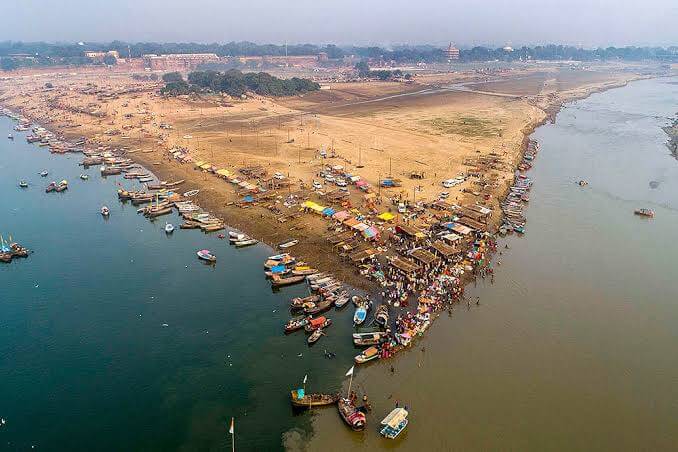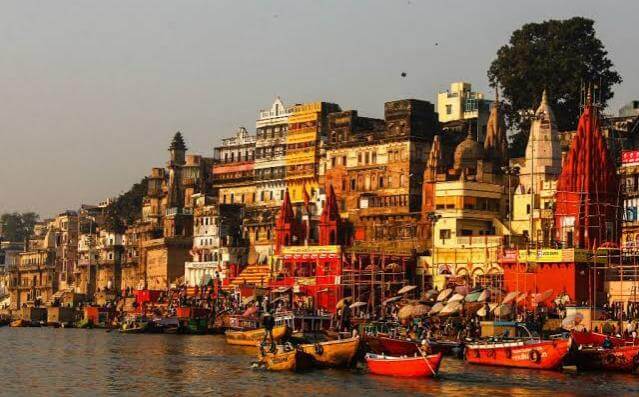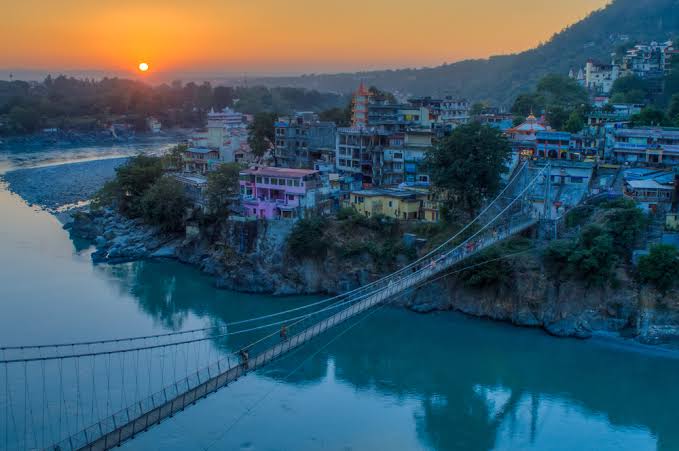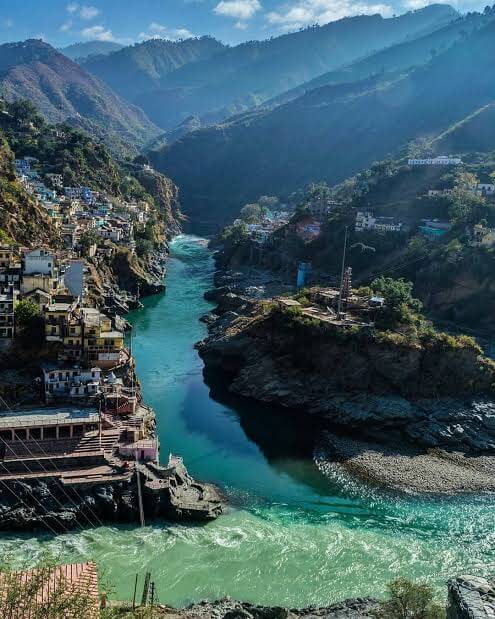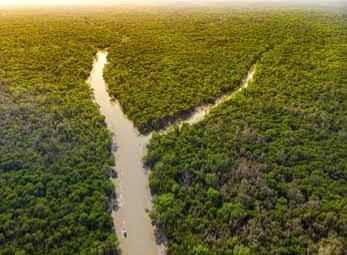Length of Ganga River
The Ganga or the Ganges is a transboundary river of Asia. Its large part flows through India and some parts through Bangladesh. In Bangladesh, the river is called the Padma. The largest city on the bank of this river is Kanpur which is a major industrial town.
A large number of people fulfill their utility by using the river’s water. The Ganga is a rich source of income for them.
Along with this, it is the holiest river for Hinduism and is worshipped as the goddess Ganga. At Devprayag, the river’s main stem begins in the confluence of the Alaknanda (source stream in hydrology) and the Bhagirathi (source stream in Hindu mythology).
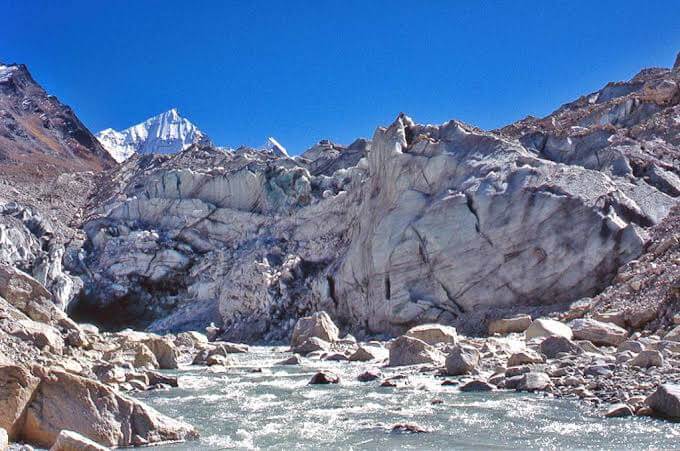
Gomukh, Uttarakhand, India
Length and Route of the River
The river’s length is 2,525 km (1,569 mi), and the size of its basin is 1,320,000 km² in the western Himalayas in Uttarakhand, India. Its origin point is called Gomukh, which is the last point of Gangotri Glacier. Ganga empties into the Bay of Bengal after covering the Gangetic Plain of North India into Bangladesh. The Ganga is the largest river in the country and is the 34th largest river in the world. The Ganga river basin is also the largest in the country as per the catchment area, covering 26% of the country’s landmass.
The river flows through:
- Uttarakhand (Rishikesh and Haridwar),
- Uttar Pradesh (Fatehgarh, Kannauj, Bithoor, Kanpur, Aligarh, Prayagraj, Varanasi, Ghazipur, etc.),
- Bihar (Patna, Munger, Bhagalpur, and Katihar),
- West Bengal (Plassey, Kolkata, Murshidabad, Haldia, Budge Budge, Diamond Harbour, Barrackpore, etc.),
- Rajshahi Division (Pabna, Ishwardi, and Rajshahi),
- Dhaka Division (Narayanganj, Dhaka, Faridpur, Munshiganj, etc.),
- Chittagong Division (Chandpur and Noakhali), and
- Barisal Division (Bhola).
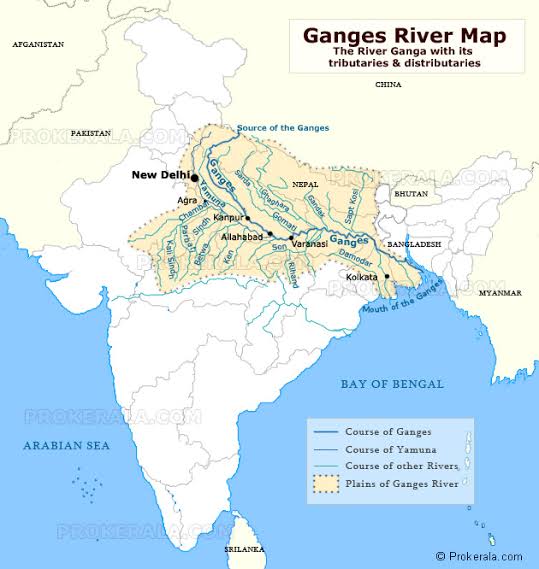
Route Map of the Ganga River
Headstreams, Distributaries, and Tributaries of the Ganga
The river has two headstreams, two distributaries, and ten tributaries. All these flow from 11 different states and, in the end, meet with the Ganga. Its two headstreams are Brahmaputra and Alaknanda. Its two distributaries are Bhagirathi and Hugli (Hooghly). The river’s left bank tributaries include Gomti, Ghaghara, Ramganga, Kosi, Mahananda, and Gandak, while its right-bank tributaries include Son, Yamuna, Tamsa, and Punpun. As per the discharge, Ghaghara (Karnali) is the largest tributary of the river, while the longest tributary of the Ganga is the Yamuna River.
Economical Support
The Ganga is the lifeline of many people. The Ganges Basin’s soil is highly fertile and plays a significant role in the agricultural economies of India and Bangladesh. Ganga and its tributaries are also perennial sources of irrigation. The chief crops grown in this large irrigated area are rice, wheat, oilseeds, sugarcane, lentils, and potatoes. Some other crops, such as chilies, mustard, jute, sesame, etc., are highly grown near the swamps and lakes located on the banks of the river.
Other than agriculture, tourism is also significant economic support for the areas where the river flows. Haridwar, Varanasi, and Prayagraj (Allahabad) are the three towns that are very hot to Hinduism and attract millions of pilgrims. River rafting is an adventurous activity for which the river is very popular. To attract tourists, riverfront walkways are also developed by several cities such as Kolkata, Kanpur, and Patna.
The Mythology of the River
Bhagirath was an ancient Indian king and the descendant of King Sagar of the Surya dynasty. Bhagirath was very kind, virtuous, and intelligent. He lost his father in his childhood. King Sagar had 60 children who got birth through his magic. All their children were fired in a curse of Sage Kapila’s. Hence, their souls could not rise to ascension in Heaven. For this purpose, Sage Kapila suggested calling the Ganga River (daughter of Life Brahma) from the Swarga (Heaven). But this was an arduous task and could not be done by many generations of Kosala Kings.
Finally, King Bhagirath decided to do the Tapasya or worship in the extreme conditions of the Himalayas. After thousand years, Lord Brahma appeared and asked him for a wish. Bhagirath demanded the same. But there was a problem, the Ganga was such a large river, and it would be impossible to save the earth from its destructive effects. So Bhagirath performed the Tapasya of Lord Shiva, and after a year, he pleased and agreed to hold the river on his Jata (matted locks). So when the river arrived from heaven, he did the same as told by Lord Shiva. Bhagirath showed the way to the river, and the Ganga flowed in the exact directions in North India. Because of Bhagirath’s efforts to bring the river on the earth, the Ganga is also called Bhagirathi.
The Kumbha Mela
In Hindu rituals, it is believed that the river is a ‘Tirtha’ that means a crossing point between the beautiful heaven and the earth. It is said that at these places, the wishes are sent directly to God and always be fulfilled.
The Kumbha Mela is organized once every three years at four different locations since the 7th century. The Ardh (half) Kumbh is celebrated at two locations named Haridwar and Prayag or Prayagraj (Allahabad). Both of these are situated at the bank of river Ganga and are believed to be very holy places. The Hindu pilgrims come to the river for bathing to make their souls pure and clean and getting good fortune. Many believers also collected the water of the river to use in the holy works and rituals. In Hinduism, a drop of the river’s water is also poured into the mouth before cremated a dead body. Some points of attraction at Kumbh other than the beautiful Ganga are devotional singing, religious assemblies, and Naga Sanyasis (Sadhus with a saffron sheet on their skin and don’t wear clothes).
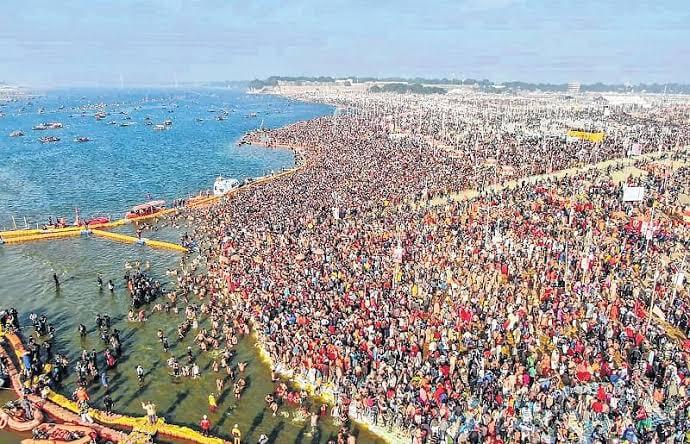
Kumbh Mela, Prayagraj, India
Popular Places Located At the Bank of the Ganga
- Haridwar: Haridwar is an ancient city and an important Hindu pilgrimage located in Uttarakhand. At this place, the river leaves the foothills of the Shivalika ranges of the Himalayas. The city is among the seven holy places or Sapta Puri. Haridwar is very popular for its Kumbh Mela. Some beautiful sites of Haridwar are Harki Pauri, Chandi Devi Temple, Mansa Devi Temple, Shiv Murti, etc.

Ganga Aarti at Haridwar, Uttarakhand - Prayagraj: Prayagraj or Allahabad is a holy city of Uttar Pradesh. It is believed that the very first sacrifice of Lord Brahma was performed here. At Prayag, the Ganges meet with two other rivers named Brahmaputra and Yamuna. The point where all the three rivers meet is known as Triveni Sangam (the meeting point of three). The edge-catching sites in the city are the New Yamuna Bridge, All Saints Cathedral, Khusro Bagh, Anand Bhavan, etc.

Triveni Sangam, Prayagraj, Uttar Pradesh - Varanasi: Varanasi is one of the most sacred places for Hinduism, which is located at the bank of the Ganges. In the city, a Hindu God Temple is also located that is dedicated to Lord Shiva. The site is most famous for retirement, cremation, and spreading of all in the holy water of the river. Other than Hinduism, the city is also a sacred site to Jainism and Buddhism.

The Ganga Ghat, Varanasi, Uttar Pradesh - Rishikesh: Rishikesh is a beautiful picturesque location situated at the foothills of the Himalayas in Uttarakhand at the bank of the Ganga. Other than religious purposes, the city is also trendy for campaigns and rafting. The city is alcohol-free, traffic-free, and completely vegetarian. Some popular sites of the city are Triambakeshwar Temple, Ram Jhula, Triveni Ghat, Shiva Statue near Parmarth Niketan, etc.

Ram Jhula, Rishikesh, Uttarakhand - Devprayag: Devprayag is a small district in Tehri Garhwal district of Uttarakhand. Here, the Alaknanda River meets the Bhagirathi River and Saraswati River (the mythical underground river), and then both the rivers meet with Ganga. The Sangam (meeting point) of both these rivers can easily be identified because of the different compositions of their water. The term Devprayag means “Godly Confluence.” Some places to visit here include Danda Nagaraj Temple, Chandrabadni Temple, Dhaneshwar Mahadev Temple, Raghunath Ji Temple, etc.

Alaknanda and Bhagirathi Sangam, Devprayag, Uttarakhand - Sundarbans: Sundarban Delta or Sundarbans is the area covered with the mangrove forest in the Bay of Bengal. The confluence of the river Ganga, Brahmaputra, and Meghna is the source of its formation. The delta is located in West Bengal, India, and Bangladesh and is the largest delta in the world. The forests have a wide variety of flora and fauna with its highly fertile land. Sundarbans are included in the UNESCO World Heritage It has four protected areas also. But despite these all, the delta is considered endangered in 2020.

Sundarban Delta, West Bengal, India
Pollution
The river Ganga is facing a severe problem of pollution which is a significant threat to human as well as animal health and the larger environment. The river water fulfills the need of about 40% population of the country across 11 states. By now, it has been filled with industrial contaminants and human wastes. It is the fifth most polluted river on the planet. The pollution is also severely affecting the marine life in the river. The Ganges river dolphin is an endangered species with a total population of 2000. The main reason behind this reducing population is the development of hydroelectric and irrigation dams that stops these dolphins from traveling up and downriver. Ganges’ soft-shell turtle is also facing heavy metals pollution. The polluted water of the river can also cause dysentery, hepatitis, cholera, and diarrhea. Other than this, clearing a large area of forest for the construction of dams is also a significant problem. For example, 1200 hectares of forest were wiped out to construct the Kotli-Bhel dam at Devprayag.
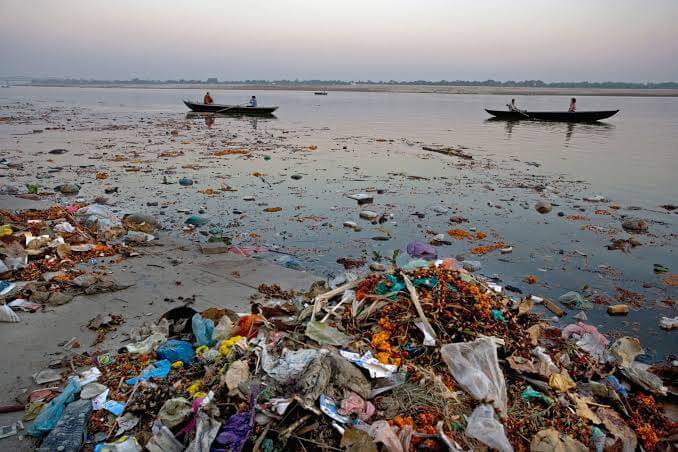
Pollution in the Ganga River
Other Environmental Concerns
- Mining: In Haridwar, Uttarakhand, the illegal mining activities in the Ganga river bed is a big problem for a long. A large amount of stones and sand is mined every year. However, quarrying is banned in the area zone of 140 km²ofKumbhMela in Haridwar.
- Water Shortage: The problem of water shortages is getting worse in the river and in the cities that are located on its bank. It has been dried in some sections, and in the other, the water level is worrying. For example, at some places in Varanasi, the river has a depth of 60 meters, while at the other, it is only 10 meters.
Cleanup Efforts
- Ganga Mahasabha: In 1905, this Indian organization was formed by Madan Mohan Malaviya. On 5 November 1914, it was agreed by British India that Hindu believers have a rudimentary right over the uninterrupted flow of the river. After the introduction of the Agreement of 1916, the day is known as an ‘Aviral Ganga Samjhauta Divas.’
- Ganga Action Plan: The plan was launched by the former PM of India Rajiv Gandhi in June 1986. The project had the aim of making the water quality better. For this purpose, several actions were taken, which include rerouting, stopping, and treating the domestic sewage. Other than this, reducing the flow of toxic and industrial chemical wastes was also the objective of the project.
- National River Ganga Basin Authority (NRGBA): The act was launched by the Central Government of India on 20 February 2009 under Section 3 of the Environmental Protection Act, 1986. The program declares the Ganga as the country’s “National River”. In 2011, the World Bank provided a fund of $1 billion for the NRGBA.
- 2010 Government Cleanup Campaign: In 2010, a campaign of $4 billion was embarked by the Government of India to completely stop the entry of untreated municipal sewage or industrial runoff within the area of 1,560 miles of the river Ganga by the year 2020. Many industrial plants like Tulsi and others are relocated by the Supreme Court of India along the river. The river zone between Gaumukh and Uttarkashi is proclaimed as an eco-sensitive zone by the government.
- Namami Gange Programme: This Ganga Development Project was launched on 10 July 2014 with the title “Namami Gange,” which means obeisance to the Ganges River. 2,037 crores were invested in the project for reducing pollution, protection, and recreation of the river. These pillars include:
- Sewerage Treatment Infrastructure
- Industrial Effluent Monitoring
- Public Awareness
- River-Surface Cleaning
- River-Front Development
- Bio-Diversity
- Ganga Gram
- Afforestation
- Ganga Manthan: It was a national conference held to consult about the various problems and solutions for cleaning the Ganga. A road map was prepared to rejuvenate the Ganges, and the feedbacks were taken from stakeholders in the conference. The event was organized on 7 July 2014 at Vigyan Bhavan in New Delhi by the National Mission for Clean Ganga.


